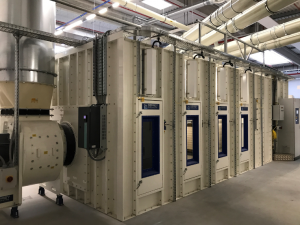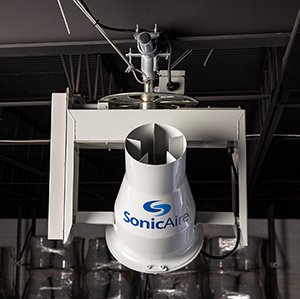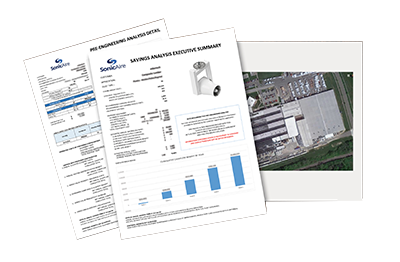“How do we manage all this dust?”
When your operations generate dust—from cutting, grinding, polishing, shaping, transporting, mixing, cleaning and more—this is a crucial question to ask. The proper management of industrial dust is essential to keep facilities safe and compliant. And this requires good housekeeping measures.
For many facilities, best practices include a healthy combination of dust control solutions. Facility managers are discovering that a pairing of industrial dust fan systems and dust collection systems is an effective approach. Here’s how it works.
Dust Collection Systems

“But given the general design of these types of production lines, there’s going to be fine dust that escapes,” said Ankenbrandt. “Typically what happens is the dust floats up because it’s so light, and then it lands on any kind of horizontal surface.”
These particles then settle and accumulate in overhead areas, which means facility owners still need a system in place to manage the build-up of dust. Ankenbrandt continued, “SonicAire fans create an “air curtain” which impedes the migration of the very light dust up to roof joists and overhead ductwork. Instead, the very light dust is forced down, where people can sweep the floor, clean machinery, and they don’t have to get up on lifts to do it.”
As one Pennsylvania-based wood pellet manufacturer noted, “Even if we contained 99.99% of the dry dust going into the mill, that would still lead to over 130 pounds of dry dust becoming airborne per week from each pellet mill.”
Tracy Gray, Plant Manager of the Continental Structural Plastics, adds, “Sanding composite components generates dust that transfers up, and above, and everywhere. A dust collection system can pull the dust away from operators to avoid inhalation, but you’ll still have the housekeeping issue for overhead areas.”
So how can facility owners manage this airborne dust? The solution is a second housekeeping tool: dust control fans.
Dust Control Fans
Industrial dust control fans are an effective solution to manage all the dust that bypasses a dust collection system and work in conjunction with that system. By controlling airflow and dust circulation, the fans prevent dust accumulation on overhead areas. “Where SonicAire fans come in is they create an air barrier so the dust can’t reach the rafters,” Ankenbrandt said. The fans keep dust contained to the floor level, where it can be more easily managed. “SonicAire fans force the dust down, where people can sweep the floor, clean the machinery, and they don’t have to get up on lifts to do it,” he said.
And unlike dust collection systems, which must be emptied and cleaned frequently, the fans require little to no maintenance as they perform continual dust management. Dust collection systems typically feature ducting systems, filters, separators and possibly even complex precipitators. Industrial dust control fans, on the other hand, prevent dust build-up using simple airflow management. The system is straightforward and effective, offering a streamlined solution for facility owners that does not add to regular maintenance tasks.
3 Game Changers
This combination of dust control measures provides significant cost-saving benefits:
- Mitigates risk: When overhead dust is improperly managed, it poses a serious hazard. OSHA reports that a layer of dust as thin as a paperclip can contribute to a combustible dust event. These explosions and fires can cause crippling damage to a facility, including loss of life. By putting quality housekeeping measures in place, facility managers virtually eliminate the risk of these disasters.
- Increases productivity: Dust control fans and dust collectors perform ongoing dust maintenance to prevent dust build-up. This reduces manual housekeeping and shutdowns that are often necessary for cleaning. It also creates a cleaner, safer environment, which has been shown to increase employee morale and productivity. Lastly, these measures help prevent combustible dust events, which can shut down productivity completely.
- Maintains compliance: Failure to comply with OSHA and NFPA regulations can be costly. OSHA penalties for combustible dust non-compliance range from $5,000 to $70,000 per violation. Effective housekeeping measures ensure a facility remains clean and safe, to easily comply with current regulations.
Putting Dust Control Solutions in Place
The SonicAire solution: Applying proprietary BarrierAire™ technology, SonicAire fan systems use thermal-current control and high-velocity airflow to prevent dust accumulation. The systems offer an engineered, robotic solution to control overhead dust and reduce housekeeping costs, while maintaining safe, compliant conditions.
Free site analysis: Each industrial dust control fan system is customized to meet the needs of individual facilities. Contact SonicAire to receive a custom site analysis, ROI calculation and project quote.


